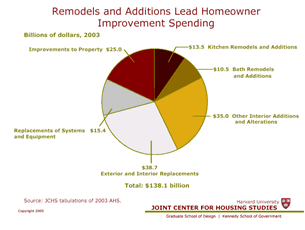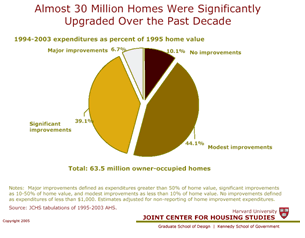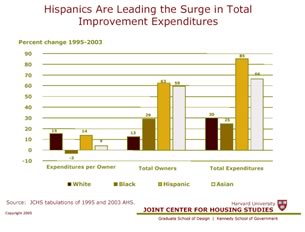

6/2006
Panel offers tips on taking advantage of growing sector

by Tracy Ostroff
 “There is a lot of potential for architects,” said Kermit
Baker, PhD, Hon. AIA, the AIA’s chief economist and fellow at Harvard
University’s Joint Center for Housing Studies (JCHS), of the $275-billion
residential renovation market. At the June 10 AIA national convention
seminar, “Opportunities in the Home Improvement Market for Residential
Architects,” moderator Kevin Harris, AIA, Small Project Practitioners
Knowledge Community Advisory Group member, with panelists Baker and Deborah
Pierce, AIA, Pierce Lamb Architects, West Newton, Mass., framed for attendees
how they are uniquely qualified to take advantage of this expanding niche
market and offered ideas for building a residential remodeling practice.
“There is a lot of potential for architects,” said Kermit
Baker, PhD, Hon. AIA, the AIA’s chief economist and fellow at Harvard
University’s Joint Center for Housing Studies (JCHS), of the $275-billion
residential renovation market. At the June 10 AIA national convention
seminar, “Opportunities in the Home Improvement Market for Residential
Architects,” moderator Kevin Harris, AIA, Small Project Practitioners
Knowledge Community Advisory Group member, with panelists Baker and Deborah
Pierce, AIA, Pierce Lamb Architects, West Newton, Mass., framed for attendees
how they are uniquely qualified to take advantage of this expanding niche
market and offered ideas for building a residential remodeling practice.
 The remodeling market has almost doubled in size over the past decade,
Baker reported. He noted that the residential remodeling market is a
growing sector, accounting for more than 2 percent of the nation’s
economy, as well as for 40 percent of all residential construction and
improvement spending in the U.S. Almost 30 million homes were significantly
upgraded over the past decade, with large projects—having unique
design challenges—capturing a growing market share. Homeowners
spent $24 billion on kitchen and bath remodels and additions, $35 million
on other interior additions and alterations, and $25 million on improvements
to properties. Exterior and interior replacements topped out at $38.7
billion.
The remodeling market has almost doubled in size over the past decade,
Baker reported. He noted that the residential remodeling market is a
growing sector, accounting for more than 2 percent of the nation’s
economy, as well as for 40 percent of all residential construction and
improvement spending in the U.S. Almost 30 million homes were significantly
upgraded over the past decade, with large projects—having unique
design challenges—capturing a growing market share. Homeowners
spent $24 billion on kitchen and bath remodels and additions, $35 million
on other interior additions and alterations, and $25 million on improvements
to properties. Exterior and interior replacements topped out at $38.7
billion.
 Homes that are 25–30 years old are most likely to see improvements and
remodeling, with pressing needs to replace major systems, making it a
convenient time to undertake “while we’re at it” remodeling
projects. As homes in the Sunbelt age, the pace of remodeling in the
region is picking up. Younger households are active in the market, providing
opportunities for building long-term relationships, Baker suggested.
Homes that are 25–30 years old are most likely to see improvements and
remodeling, with pressing needs to replace major systems, making it a
convenient time to undertake “while we’re at it” remodeling
projects. As homes in the Sunbelt age, the pace of remodeling in the
region is picking up. Younger households are active in the market, providing
opportunities for building long-term relationships, Baker suggested.
Market demographics
Baker detailed who is spending construction dollars and how. “Each
generation is outspending its predecessor on home improvement,” Baker
reported. Data from 2004 show that Baby Boomers account for just over
half the residential remodeling market, with the pre-war generation and
Generation X following at 20 percent. Activities are concentrated in
the upper-end markets, with 52 percent of all spending coming from households
spending $10,000 or more on improvement, and 31 percent from households
spending $25,000 or more, in data compiled for a 2003 study.
 “Baby boomers are key to the growth of the residential market
. . . we might have expected that market to diminish, but it actually
stayed stable” as
they watched home prices rise and took advantage of the equity in their
home, Baker noted.
“Baby boomers are key to the growth of the residential market
. . . we might have expected that market to diminish, but it actually
stayed stable” as
they watched home prices rise and took advantage of the equity in their
home, Baker noted.
Perhaps the most profound shift is in the change in remodeling demographics, with minority participation in housing markets markedly increasing across the board. Over the coming decade, minorities will account for nearly half of the increase in homeowners, Baker said. He reported that Hispanics are leading the surge in total improvement expenditures.
Successful residential renovation practices
Kicking off his portion of the seminar, Harris explained why architects
should feel comfortable taking on remodeling projects. “Few people
realize how complicated renovations can be. An architect is the one
professional who has the education, training, experience, and vision
to guide a homeowner through the entire design and construction process—defining
the wants, finding the need, and helping achieve the most for the construction
dollars spent.” He also noted:
- No two residential remodeling projects are the same.
- Architects can help the client achieve the most for the construction dollars spent.
- Architects also can help find the right balance for the project. “Don’t give more horsepower than they need.”
- Trained as generalists, architects are accustomed to integrating building systems, style, circulation, function, codes, and zoning issues.
Noting the impression that some are hesitant to enter the market for fear that “serious architects” do not do residential renovation, Harris offered his reasons for building his practice:
- Strong demand
- Great variety
- Always challenging
- Ability to fix what is wrong
- Personal relationships with end users
- Maintain and improve neighborhoods
- “Green” option to tear downs and sprawl.
 Harris noted that when he started he didn’t know he had a market.
His practice began when he was a full-time teacher at Louisiana State
University and started working on front porches, kitchens, and baths.
Now he’s a full-time practicing architect at his workload limit,
with 14 months of back work to boot.
Harris noted that when he started he didn’t know he had a market.
His practice began when he was a full-time teacher at Louisiana State
University and started working on front porches, kitchens, and baths.
Now he’s a full-time practicing architect at his workload limit,
with 14 months of back work to boot.
Marketing
Harris markets his practice by:
- Word of mouth (this makes up 90 percent of his marketing effort)
- Holiday cards
- Job-site signs
- Engaging local media, including writing articles for free; he calls the exercise “self-serving,” but useful to generate awareness in households
- Community involvement
- Personal contacts
- Referrals.
Pierce, who currently has a three-person practice that extends to other sectors, says residential remodeling has steadily increased as other project types have ebbed and flowed. She follows a marketing plan that “puts people first, buildings second.” That strategy results in finding good clients who support good design, give great references, help make the job fun, and allow post-construction access. “Good buildings plus bad clients equals heartbreak,” said Pierce. She offered that the architect should “be patient, expect selective perception, feed new info in small bites, and remember this is only half of the story.”
Pierce also recommended that attendees focus on value, including aesthetics, comfort, function, and delight; enhanced investment in property; and making a connection to the initial client wish-list, dispute resolution, and money management. She counseled the architects to embrace adversity, noting that “difficult people are our best teachers, while difficult projects expand out skill sets.” At the same time, however, she advised practicing stress relief and knowing when to walk away.
 Firm management
Firm management
Pierce and Harris described the evolution of their practices. Harris
started out with several part-time interns he had trouble retaining.
Now he employs six full-time interns and two “virtual” off-site
interns divided into studios, with a part-time office manager and part-time
accountant as well as two part-time student workers. He said all renovations
begin with a paid design consultation, which allows him a holistic
view of his clients and the project. From that meeting, he will recommend
whether they should go forward with an alternative delivery or hire
him to do the job. Generally, if the homeowner decides to go forward
with the project, Harris works with them as they move through a review
of existing conditions, schematic design, construction documents, and
contract administration. He said—and Pierce agreed—that
the client should choose the contractor.
Harris must wear many hats to keep the cogs rolling. He suggested hiring a staff member to manage finances, so the architect does not have to be asking for money while still on the job.
Pierce heads a three-person firm, but counts among her colleagues a “virtual firm” of consultants, marketing managers, accountants, and lawyers she hires to accomplish specific tasks in three areas of practice: office administration, design, and project delivery. The ring of the virtual firm extends even further to architect colleagues, craftspeople, artisans, AIA Knowledge Communities, product representatives, and continuing-education providers.
Pierce offered keys to successful project management:
- Have written contracts
- Deal with scope-creep
- Beware working with friends and family
- Create a paper trail
- Keep your agreements, no matter what
- Take on consultants who share your commitments
- Always maintain the business relationship
- Provide construction administration.
She also advised the architects to listen to the clients, including showing respect for client ideas, watching out for cold feed, engaging them and understanding where they are coming from, and nurturing referrals. Pierce suggests “getting comfortable with money,” including “asking for a retainer up front, invoicing promptly and with great clarity, collecting timely, always knowing your bottom line, and loving profitability.”
Best practices
For Pierce, a best practice lies in a data-tracking book she keeps on
all her projects. She tracks:
- Job name, number, date
- Square-foot area
- Construction costs: estimate, bids, contract sum, final cost
- Architectural and consultant fees
- Reimbursed costs
- Profit (or loss)
- A/E fees as percent of construction
- Construction cost per square foot.
And perhaps the most practical advice of all from Harris’ conclusion: “If the project involves both a kitchen and bath renovation, the client should move out!”
Copyright 2006 The American Institute of Architects.
All rights reserved. Home Page ![]()
![]()
![]()